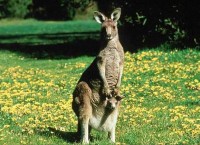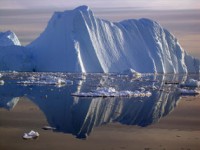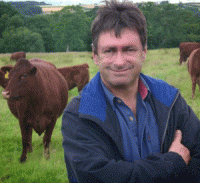
|
Oct 11, 2007
Chilly Temperatures During the Maunder Minimum
NASA Earth Observatory
Many things can change temperatures on Earth: a volcano erupts, swathing the Earth with bright haze that blocks sunlight, and temperatures drop; greenhouse gases trap heat in the atmosphere, and temperatures climb. From 1650 to 1710, temperatures across much of the Northern Hemisphere plunged when the Sun entered a quiet phase now called the Maunder Minimum. During this period, very few sunspots appeared on the surface of the Sun, and the overall brightness of the Sun decreased slightly. Already in the midst of a colder-than-average period called the Little Ice Age, Europe and North America went into a deep freeze: alpine glaciers extended over valley farmland; sea ice crept south from the Arctic; and the famous canals in the Netherlands froze regularly—an event that is rare today (Icecap Note: happened in the winter of 2005/06).

The impact of the solar minimum is clear in this image, which shows the temperature difference between 1680, a year at the center of the Maunder Minimum, and 1780, a year of normal solar activity, as calculated by a general circulation model. Deep blue across eastern and central North America and northern Eurasia illustrates where the drop in temperature was the greatest. Nearly all other land areas were also cooler in 1680, as indicated by the varying shades of blue. The few regions that appear to have been warmer in 1680 are Alaska and the eastern Pacific Ocean (left), the North Atlantic Ocean south of Greenland (left of center), and north of Iceland (top center).
If energy from the Sun decreased only slightly, why did temperatures drop so severely in the Northern Hemisphere? Climate scientist Drew Shindell and colleagues at the NASA Goddard Institute for Space Studies tackled that question by combining temperature records gleaned from tree rings, ice cores, corals, and the few measurements recorded in the historical record, with an advanced computer model of the Earth’s climate. Read more here.
Oct 11, 2007
They Will ‘Roo’ the Day
By Karen Collier, Herald Sun
Greenpeace urges kangaroo consumption to fight global warming. More kangaroos should be slaughtered and eaten to help save the world from global warming, environmental activists say. The controversial call to cut down on beef and serve more of the national symbol on our dinner plates follows a report on curbing greenhouse gas emissions damaging the planet. Greenpeace energy campaigner Mark Wakeham urged Aussies to substitute some red meat for roo to help reduce land clearing and the release of methane gas. “It is one of the lifestyle changes we can make,” Mr Wakeham said. “Changing our meat consumption habits is a small way to make an impact.” The eat roo recommendation is contained in a report, Paths to a Low-Carbon Future, commissioned by Greenpeace and released today.

It also coincides with recent calls from climate change experts for people in rich countries to reduce red meat and switch to chicken and fish because land-clearing and burping and farting cattle and sheep were damaging the environment.
Today’s report by leading scientist Dr Mark Diesendorf, from the University of NSW, says greenhouse gas emissions need to be slashed by at least a third by 2020 to avoid a climate change catastrophe. His recommendations include: (1) Reducing beef consumption and increasing kangaroo meat production, (2) Cutting gas and coal production. (3) Halting land clearing and deforestation, (4) Shifting to renewable energy such as wind power and bioelectricity from crop residues. “The world is currently on track to experience runaway global warming with average temperatures soon to exceed 2 degrees above pre-industrial levels, Dr Diesendorf said. “We face a catastrophe unless there is urgent action to cut greenhouse gas emissions by at least 30 per cent by 2020.”
A major report by the CSIRO and Bureau of Meteorology released this month warned average temperatures will rise 1C by 2030 and could increase as much as 5C in Australia by 2070 unless global greenhouse emissions are cut dramatically.
Icecap note: Dr. Diesendorf seems to have left off two of the most important sources of hot air in the Southern Hemisphere, CSIRO and the BOM
Oct 09, 2007
Younger Dryas Glaciation Northern Hemisphere Only?
Science Alert, 8 October 2007
If the Earth is heading for a new ice age, Australia may not be as affected as countries in the Northern Hemisphere, according to new research from The Australian National University published in Science. Dr Timothy Barrows, a palaeoclimatologist at the ANU Research School of Physical Sciences and Engineering, says that a freak cooling at the end of the last ice age 12,900 years ago, was a phenomenon felt only in the north, not globally as previously thought.
This rapid cooling, which brought on an ice age for 1400 years, is known as the Younger Dryas event. It was caused by a disruption of ocean circulation in the Atlantic Ocean, which could occur again if the Greenland Ice Sheet were to melt.

“It was thought that climate change was always global, but our research shows that is not necessarily the case, in fact what happens in the north can be the opposite of what happens in the south. So if the Greenland Ice Sheet does melt because of global warming, triggering another ice age, Australia and New Zealand are the places to be,” Dr Barrows said. Read more here.
Oct 06, 2007
Prominent BBC Naturalist Joins Skeptics: ‘Our Climate Has Always Changed’
By Michael Deacon, UK Telegraph
One subject gets Titchmarsh more worked up than accusations of blandness, though. Perhaps, coming from a man who loves nature, it’s a slightly surprising one: our obsession with global warming.
‘I wish we could grow up about it,’ he says. ‘I’m sure we are contributing to global warming, and we must do all we can to reduce that, but our climate has always changed. The Romans had vineyards in Yorkshire. We’re all on this bandwagon of ‘Ban the 4x4 in Fulham’. Why didn’t we have global warming during the Industrial Revolution? In those days you couldn’t have seen across the street for all the carbon emissions and the crap coming out of the chimneys.’ He pauses for breath, then smiles. ‘Sorry, bit of a tirade there.’
Surely he worries that global warming may threaten some of the species in his series. But this doesn’t seem to bother him too much. ‘We’ll lose some, we’ll gain others,’ he says. ‘Wildlife is remarkably tenacious. Nature always copes.’

Alan Titchmarsh, UK Naturalist
Oct 03, 2007
Scientific Consensus on Man-Made Ozone Hole May Be Coming Apart
Nature
As the world marks 20 years since the introduction of the Montreal Protocol to protect the ozone layer, Nature has learned of experimental data that threaten to shatter established theories of ozone chemistry. If the data are right, scientists will have to rethink their understanding of how ozone holes are formed and how that relates to climate change.
Markus Rex, an atmosphere scientist at the Alfred Wegener Institute of Polar and Marine Research in Potsdam, Germany, did a double-take when he saw new data for the break-down rate of a crucial molecule, dichlorine peroxide (Cl2O2). The rate of photolysis (light-activated splitting) of this molecule reported by chemists at NASA’s Jet Propulsion Laboratory in Pasadena, California1, was extremely low in the wavelengths available in the stratosphere - almost an order of magnitude lower than the currently accepted rate.
“This must have far-reaching consequences,” Rex says. “If the measurements are correct we can basically no longer say we understand how ozone holes come into being.” What effect the results have on projections of the speed or extent of ozone depletion remains unclear.
Other groups have yet to confirm the new photolysis rate, but the conundrum is already causing much debate and uncertainty in the ozone research community. “Our understanding of chloride chemistry has really been blown apart,” says John Crowley, an ozone researcher at the Max Planck Institute of Chemistry in Mainz, Germany.
“Until recently everything looked like it fitted nicely,” agrees Neil Harris, an atmosphere scientist who heads the European Ozone Research Coordinating Unit at the University of Cambridge, UK. “Now suddenly it’s like a plank has been pulled out of a bridge.” Post is here.
|
|
|
|






